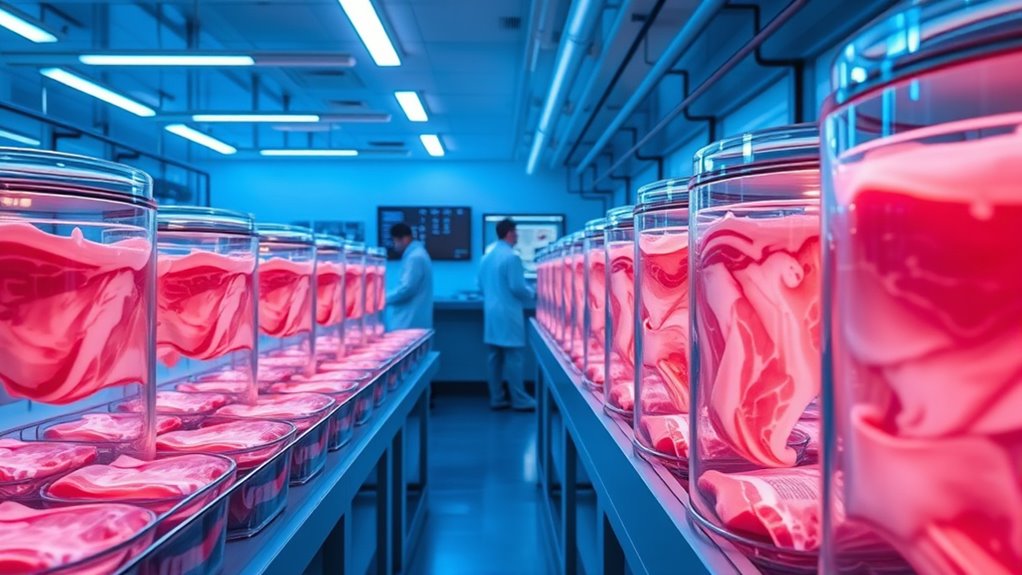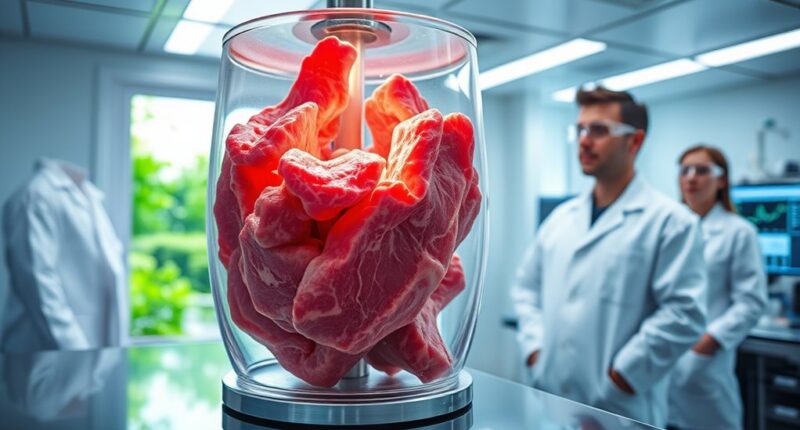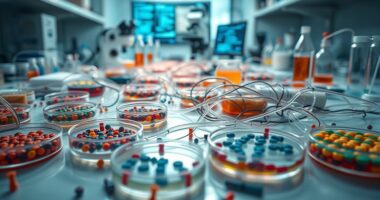Lab-grown meat is much cleaner for the environment than traditional livestock farming. It produces fewer greenhouse gases and uses less land, water, and energy. This means less habitat destruction and water waste. It also eliminates the need to raise and slaughter animals, addressing animal welfare concerns. By choosing lab-grown meat, you’re helping reduce climate change impacts and supporting sustainable food systems. Keep exploring to understand how this innovation can truly transform our planet.
Key Takeaways
- Lab-grown meat produces significantly lower greenhouse gas emissions than traditional livestock farming.
- It requires less land and water, conserving natural resources and habitats.
- Cultivated meat eliminates animal slaughter, promoting ethical and animal welfare goals.
- Reduced reliance on large-scale farms helps mitigate climate change drivers.
- Controlled production ensures a reliable, sustainable protein source with minimal environmental impact.

Lab-grown meat has gained attention as a promising alternative to traditional livestock farming, promising to reduce environmental harm. As you explore this innovative option, you’ll see how it aligns with your values of sustainable farming and ethical consumption. Unlike conventional meat production, lab-grown meat is cultivated from animal cells in controlled environments, bypassing the need for raising and slaughtering animals. This shift not only addresses animal welfare concerns but also substantially cuts down on the environmental footprint associated with traditional farming.
One of the most compelling advantages of lab-grown meat is its potential to drastically reduce greenhouse gas emissions. Livestock farming is a major contributor to methane and carbon dioxide emissions, which drive climate change. By choosing lab-grown options, you support a method that produces fewer emissions, helping to combat global warming. Furthermore, this technology requires less land and water than traditional agriculture, making it a more sustainable choice. When you opt for lab-grown meat, you’re actively participating in sustainable farming practices that conserve essential resources and diminish habitat destruction caused by expanding livestock operations.
In addition to environmental benefits, lab-grown meat promotes ethical consumption. You no longer need to worry about the welfare of animals subjected to intensive farming conditions. Instead, you can enjoy meat products that are ethically produced, with no animals harmed or exploited. This aligns with a growing movement towards compassionate choices that consider animal rights and minimize suffering. As awareness around ethical concerns rises, more consumers are seeking ways to make responsible food choices, and lab-grown meat offers a viable solution that meets these standards.
Furthermore, lab-grown meat can help stabilize food systems by reducing the volatility associated with traditional agriculture. It can be produced in controlled environments, unaffected by weather fluctuations, pests, or diseases that often threaten livestock and crops. This means a more reliable supply of meat that can meet the increasing demand without expanding agricultural land or intensifying resource use. For you, this translates into access to high-quality, sustainable protein sources that align with your values of responsible consumption.
Frequently Asked Questions
How Does Lab-Grown Meat Compare to Traditional Meat in Water Usage?
When comparing lab-grown meat to traditional meat, you’ll find that lab-grown options use markedly less water. This advances water conservation efforts and enhances resource efficiency because producing lab-grown meat requires fewer feed, land, and water resources. By choosing lab-grown meat, you’re supporting a more sustainable approach to food production, reducing the strain on water supplies, and helping to mitigate environmental impact, all while enjoying a similar taste and texture.
What Are the Potential Environmental Risks of Lab-Grown Meat Production?
You might think lab-grown meat is completely eco-friendly, but there are risks. Genetic modification could introduce unintended environmental effects, like disrupting ecosystems if mismanaged. Waste management is another concern, as production generates chemical and biological waste that needs proper disposal. If not handled carefully, these issues might harm the environment, highlighting the importance of strict regulation and responsible practices to minimize potential risks of lab-grown meat production.
Can Lab-Grown Meat Reduce Global Greenhouse Gas Emissions?
You can see that lab-grown meat has the potential to reduce global greenhouse gas emissions considerably. Its sustainability benefits include lower land and water use, which help protect ecosystems. Plus, it addresses ethical considerations by offering a cruelty-free alternative to traditional meat. By choosing lab-grown options, you contribute to a more sustainable food system, helping cut emissions and lessen environmental impact while supporting ethical farming practices.
How Scalable Is Lab-Grown Meat Production Globally?
You might worry about scaling challenges, but lab-grown meat production is becoming more feasible globally. Advances in bioreactor technology and streamlined supply chains help overcome previous hurdles, making large-scale production possible. While initial costs are high, increasing demand and innovation drive down expenses. So, with continued development, you can expect lab-grown meat to become a scalable, sustainable option worldwide, transforming how we meet future food needs.
What Are the Long-Term Environmental Impacts of Lab-Grown Meat?
You might wonder about the long-term environmental impacts of lab-grown meat. It generally reduces greenhouse gases and land use, but its sustainability depends on using renewable energy for production and sustainable packaging. By choosing eco-friendly materials and powering facilities with renewable energy, you can help minimize environmental harm. This way, lab-grown meat becomes a more sustainable option, supporting a greener future while reducing your carbon footprint.
Conclusion
Think of lab-grown meat as a gardener tending a delicate, yet promising, sapling. With careful nurturing, it promises a greener future without disturbing the earth’s roots. While it’s not a perfect solution, it’s a step toward a more sustainable landscape—less soil turned to dust, fewer waters drained, and a smaller carbon footprint. Embrace this technology as a cautious gardener, tending a fragile hope that, with time, can bloom into a healthier planet.










